Page 423 of 634

•VALET MODE — To enter this mode the operator must
select it from the Drive Modes interface and enter a four
digit PIN code. The PIN code is not predetermined, so
the operator is free to select any four digit numeric
combination that will be easy to remember. While in
Valet Mode the following vehicle configurations are set
and locked to prevent unauthorized modification:
• Engine limited to a lowest power output state.
• Transmission locks out access to first gear and shifts
earlier than normal.
• Traction, Steering and Suspension are forced to
STREET settings.
• Steering wheel mounted paddle shifters are disabled.
• The SRT Drive Modes are not available. Pushing the
SRT button will display the unlock keypad.
• The ESC Off button is disabled. •
The Launch Control button is disabled.
NOTE:
• To exit VALET Mode the operator must enter the same
four digit PIN that was used to enter the mode. The
unlock keypad can be accessed by either pushing the
SRT button or selecting to disable Valet on the
Uconnect touchscreen.
• The vehicle will restart with VALET active if VALET
was active when the vehicle was last shut down.
• Eco (Automatic Transmission only) — Eco modifies
the vehicle’s engine and transmission settings to pro-
vide improved fuel economy at a trade-off with accel-
eration performance. Increased engine exhaust noise
and/or vibration may be noticed while Eco is active,
this is normal and will not damage the vehicle.
NOTE: Changing the Drive Mode will deactivate Eco.5
STARTING AND OPERATING 421
Page 425 of 634

NOTE:Pushing the SRT button on the center stack or
pressing the “Apps” button on the touchscreen are two
other options to access launch control features. Please
refer to “Uconnect Settings” in “Understanding Your
Instrument Panel” for further information.
2. Push the “Launch RPM Set-Up” button on the touch- screen. This screen will allow you to adjust your
launch RPM’s for optimum launch/traction.
3. Push the “Activate Launch Mode” button on the touchscreen.
4. Make sure the vehicle is not moving.
5. Make sure the steering wheel is pointing straight.
6. Hold the brake and make sure the vehicle is in “Drive” or “AutoStick” position. 7. While holding the brake, rapidly apply the accelerator
pedal to wide open throttle. The engine speed will
hold at the RPM that was set in the “Launch RPM
Set-up” screen.
NOTE: Messages will appear in the Driver Information
Display (DID) to inform the driver if one or more of the
above conditions have not been met.
8. When conditions 4 through 7 have been met, the Driver Information Display (DID) will read “Launch
Ready Release Brake”.
9. Keep the vehicle pointed straight.
Launch control will be active until the vehicle reaches
62 mph (100 km/h), at which point the ESC system will
return to its current ESC mode.
5
STARTING AND OPERATING 423
Page 426 of 634
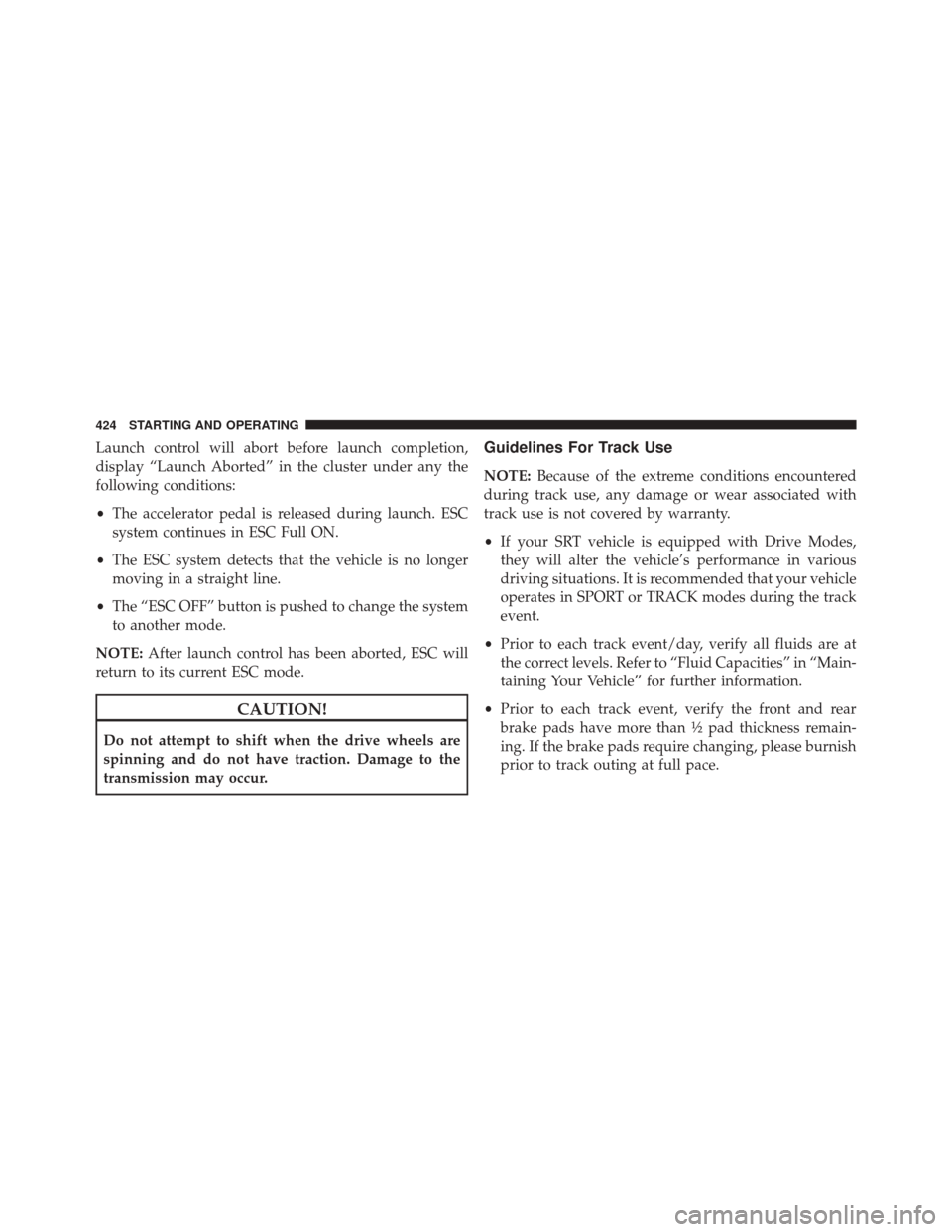
Launch control will abort before launch completion,
display “Launch Aborted” in the cluster under any the
following conditions:
•The accelerator pedal is released during launch. ESC
system continues in ESC Full ON.
• The ESC system detects that the vehicle is no longer
moving in a straight line.
• The “ESC OFF” button is pushed to change the system
to another mode.
NOTE: After launch control has been aborted, ESC will
return to its current ESC mode.
CAUTION!
Do not attempt to shift when the drive wheels are
spinning and do not have traction. Damage to the
transmission may occur.
Guidelines For Track Use
NOTE: Because of the extreme conditions encountered
during track use, any damage or wear associated with
track use is not covered by warranty.
• If your SRT vehicle is equipped with Drive Modes,
they will alter the vehicle’s performance in various
driving situations. It is recommended that your vehicle
operates in SPORT or TRACK modes during the track
event.
• Prior to each track event/day, verify all fluids are at
the correct levels. Refer to “Fluid Capacities” in “Main-
taining Your Vehicle” for further information.
• Prior to each track event, verify the front and rear
brake pads have more than ½ pad thickness remain-
ing. If the brake pads require changing, please burnish
prior to track outing at full pace.
424 STARTING AND OPERATING
Page 427 of 634

•At the conclusion of each track event, it is recom-
mended that a brake bleed procedure is performed to
maintain the pedal feel and stopping capability of your
Brembo High Performance brake system.
• It is recommended that each track outing should end
with a minimum of 1 cool down lap using minimal
braking.
• If equipped with a removable lower front fascia grille,
it is recommended to remove it for track use during
warm/hot weather to improve cooling airflow to
critical powertrain and cooling system components.
• All SRT vehicles are track tested for 24 hours of
endurance. However, it is recommended that suspen-
sion system, brake system, prop shaft, and ½ shaft
boots should be checked for wear or damage after
every track event. •
Track usage results in increased operating tempera-
tures of the engine, transmission, clutch – if equipped,
driveline and brake system. This may affect noise
(NVH) countermeasures designed into your vehicle.
New components may need to be installed to return
the system to the original NVH performance.
• Tire pressure:
• 40psi (276kpa) hot, recommend 32psi (221kpa) front,
30psi (207 kpa) rear cold
NOTE: It is recommended that you target 40psi (276kpa)
Hot Tire Pressure at the conclusion of each track session.
Starting at 32psi (221kpa) Front & 30psi (207 kpa) Rear
Cold and adjusting based on ambient & track conditions
is recommended. Tire pressure can be monitored via the
Driver Information Display (DID) and can assist with
adjustments.
5
STARTING AND OPERATING 425
Page 432 of 634
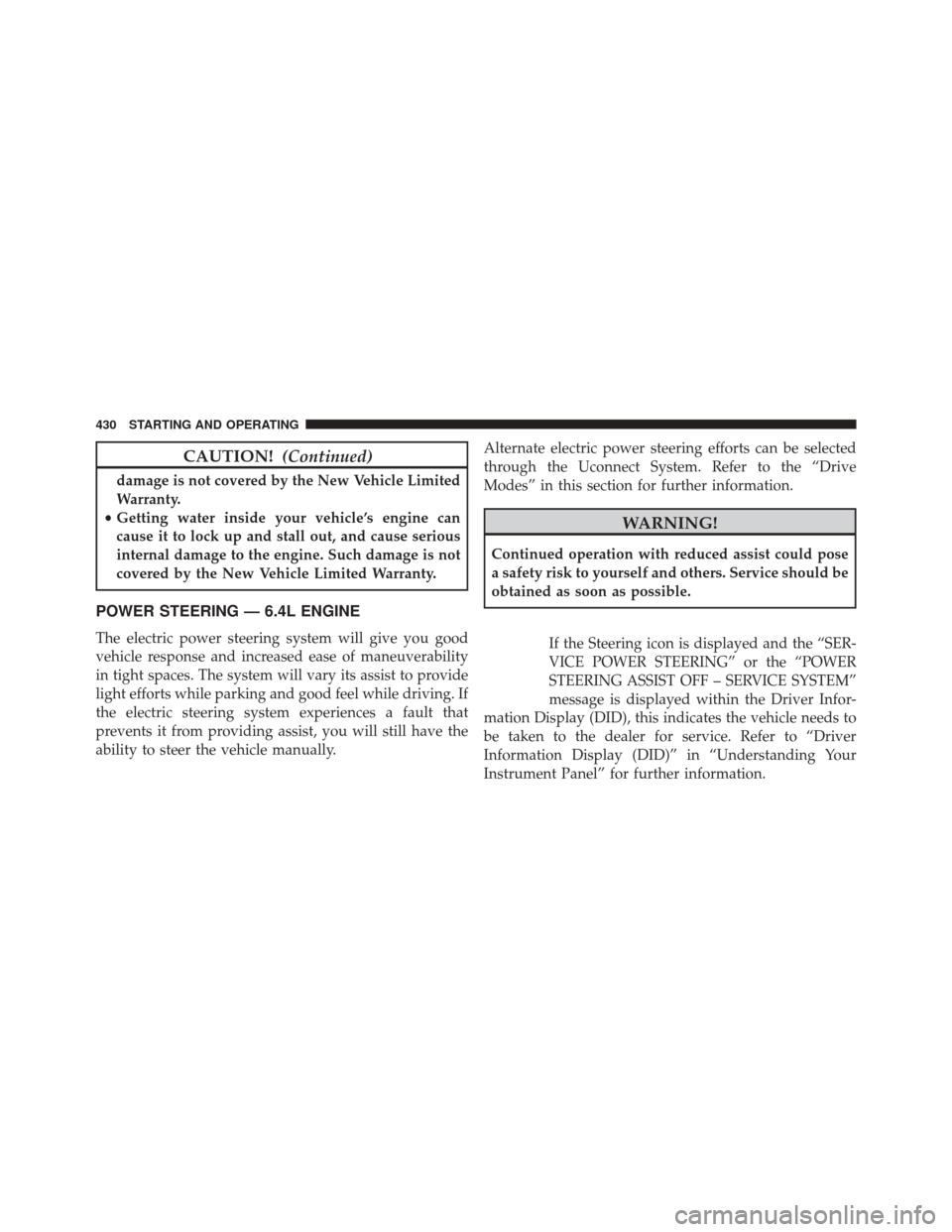
CAUTION!(Continued)
damage is not covered by the New Vehicle Limited
Warranty.
• Getting water inside your vehicle’s engine can
cause it to lock up and stall out, and cause serious
internal damage to the engine. Such damage is not
covered by the New Vehicle Limited Warranty.
POWER STEERING — 6.4L ENGINE
The electric power steering system will give you good
vehicle response and increased ease of maneuverability
in tight spaces. The system will vary its assist to provide
light efforts while parking and good feel while driving. If
the electric steering system experiences a fault that
prevents it from providing assist, you will still have the
ability to steer the vehicle manually. Alternate electric power steering efforts can be selected
through the Uconnect System. Refer to the “Drive
Modes” in this section for further information.
WARNING!
Continued operation with reduced assist could pose
a safety risk to yourself and others. Service should be
obtained as soon as possible.
If the Steering icon is displayed and the “SER-
VICE POWER STEERING” or the “POWER
STEERING ASSIST OFF – SERVICE SYSTEM”
message is displayed within the Driver Infor-
mation Display (DID), this indicates the vehicle needs to
be taken to the dealer for service. Refer to “Driver
Information Display (DID)” in “Understanding Your
Instrument Panel” for further information.
430 STARTING AND OPERATING
Page 443 of 634
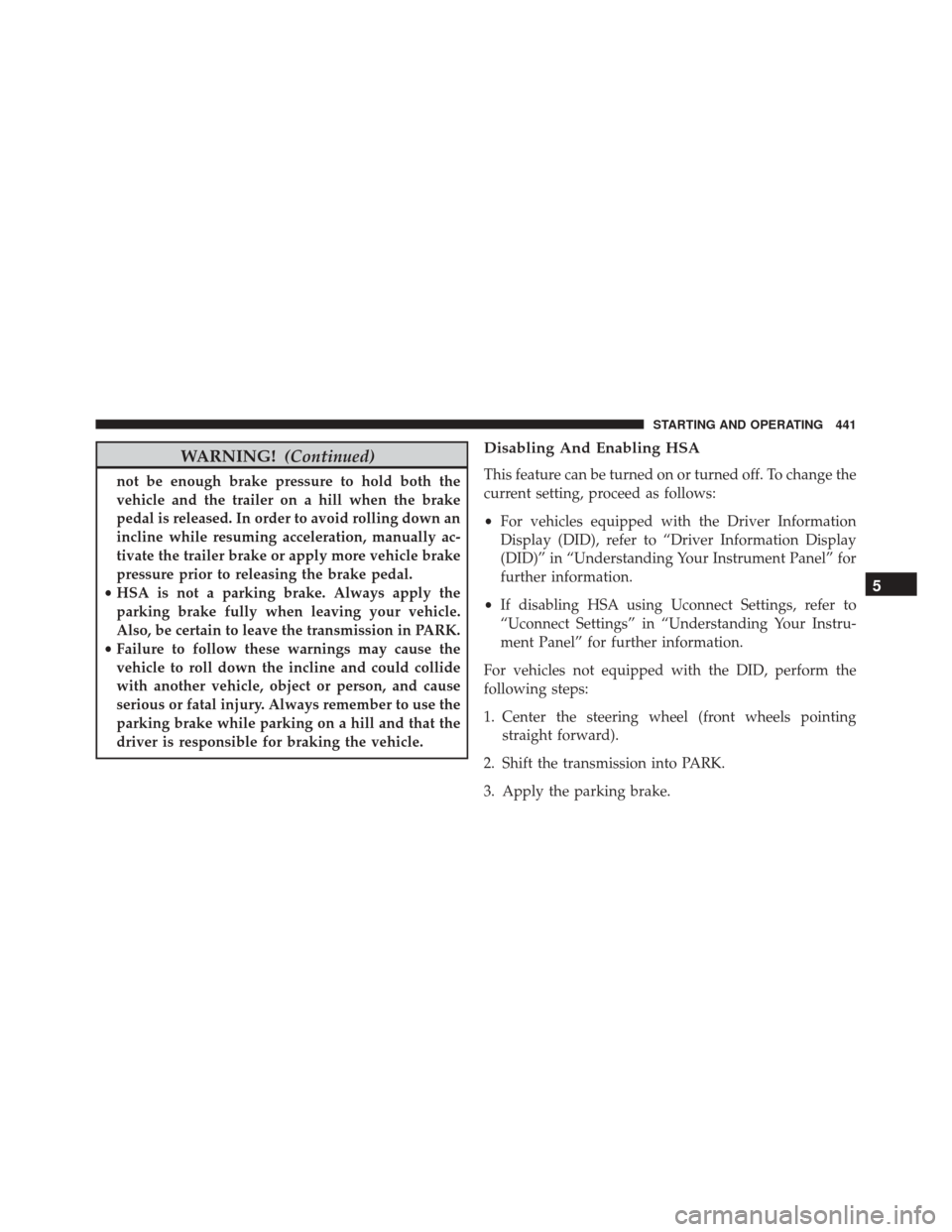
WARNING!(Continued)
not be enough brake pressure to hold both the
vehicle and the trailer on a hill when the brake
pedal is released. In order to avoid rolling down an
incline while resuming acceleration, manually ac-
tivate the trailer brake or apply more vehicle brake
pressure prior to releasing the brake pedal.
• HSA is not a parking brake. Always apply the
parking brake fully when leaving your vehicle.
Also, be certain to leave the transmission in PARK.
• Failure to follow these warnings may cause the
vehicle to roll down the incline and could collide
with another vehicle, object or person, and cause
serious or fatal injury. Always remember to use the
parking brake while parking on a hill and that the
driver is responsible for braking the vehicle.
Disabling And Enabling HSA
This feature can be turned on or turned off. To change the
current setting, proceed as follows:
• For vehicles equipped with the Driver Information
Display (DID), refer to “Driver Information Display
(DID)” in “Understanding Your Instrument Panel” for
further information.
• If disabling HSA using Uconnect Settings, refer to
“Uconnect Settings” in “Understanding Your Instru-
ment Panel” for further information.
For vehicles not equipped with the DID, perform the
following steps:
1. Center the steering wheel (front wheels pointing straight forward).
2. Shift the transmission into PARK.
3. Apply the parking brake.
5
STARTING AND OPERATING 441
Page 448 of 634
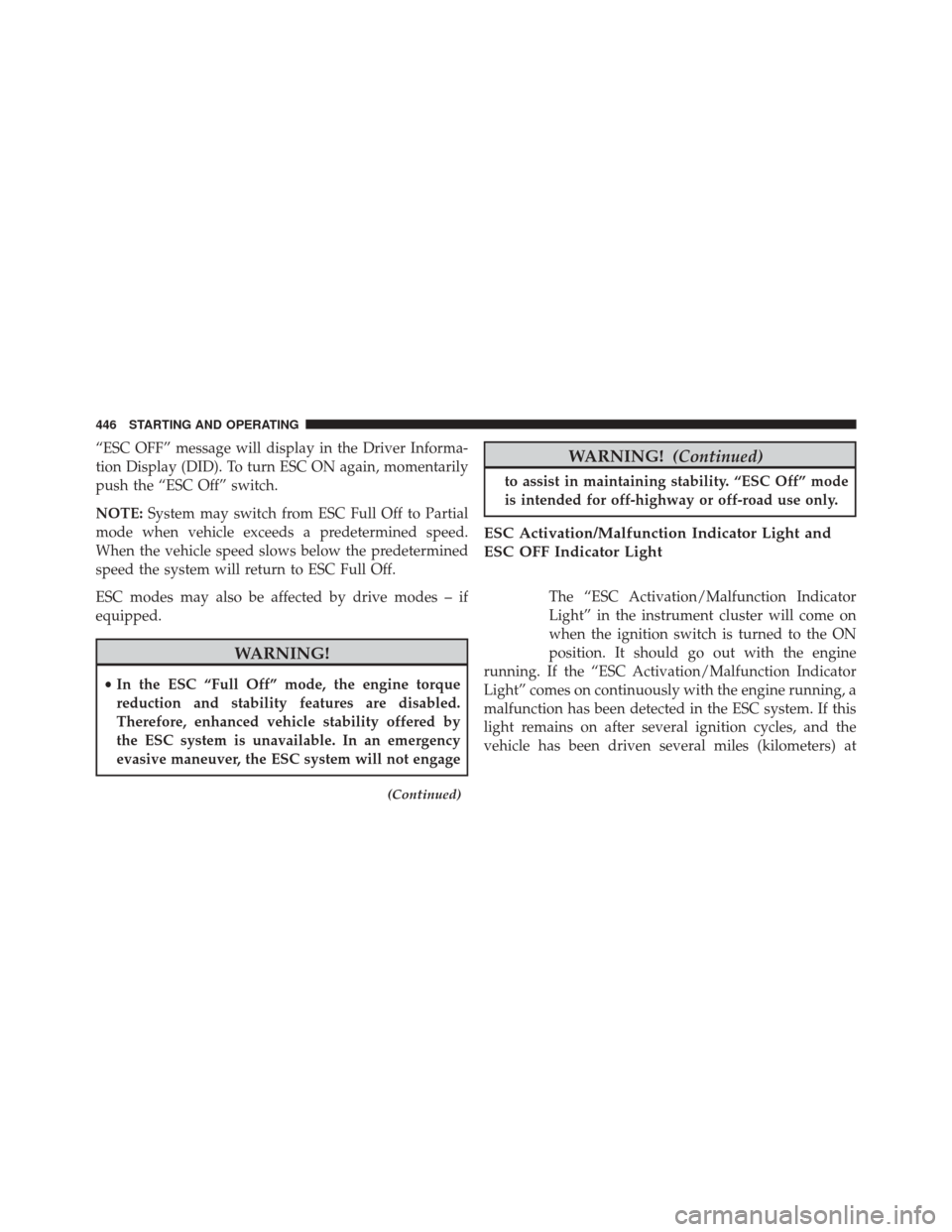
“ESC OFF” message will display in the Driver Informa-
tion Display (DID). To turn ESC ON again, momentarily
push the “ESC Off” switch.
NOTE:System may switch from ESC Full Off to Partial
mode when vehicle exceeds a predetermined speed.
When the vehicle speed slows below the predetermined
speed the system will return to ESC Full Off.
ESC modes may also be affected by drive modes – if
equipped.
WARNING!
• In the ESC “Full Off” mode, the engine torque
reduction and stability features are disabled.
Therefore, enhanced vehicle stability offered by
the ESC system is unavailable. In an emergency
evasive maneuver, the ESC system will not engage
(Continued)
WARNING! (Continued)
to assist in maintaining stability. “ESC Off” mode
is intended for off-highway or off-road use only.
ESC Activation/Malfunction Indicator Light and
ESC OFF Indicator Light
The “ESC Activation/Malfunction Indicator
Light” in the instrument cluster will come on
when the ignition switch is turned to the ON
position. It should go out with the engine
running. If the “ESC Activation/Malfunction Indicator
Light” comes on continuously with the engine running, a
malfunction has been detected in the ESC system. If this
light remains on after several ignition cycles, and the
vehicle has been driven several miles (kilometers) at
446 STARTING AND OPERATING
Page 480 of 634
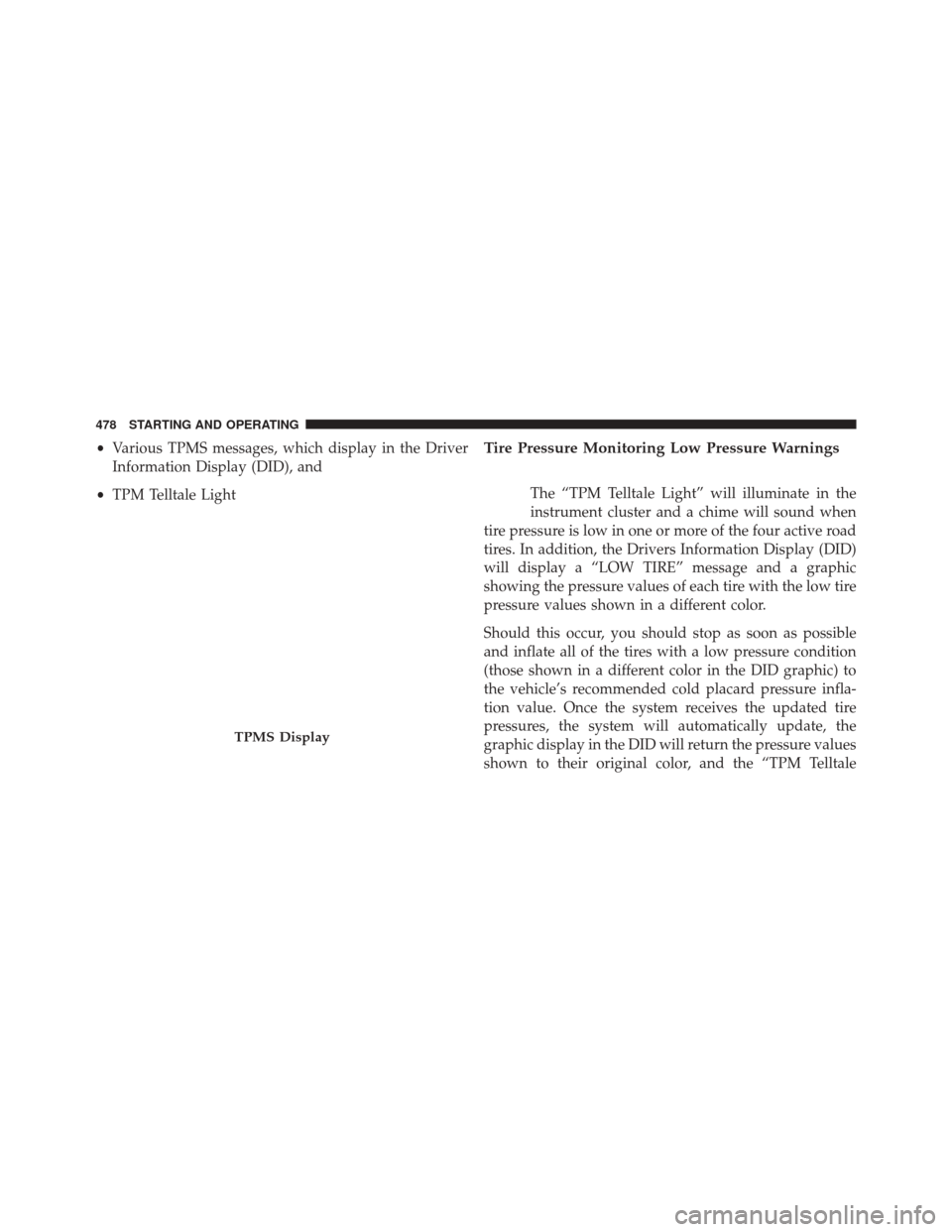
•Various TPMS messages, which display in the Driver
Information Display (DID), and
• TPM Telltale LightTire Pressure Monitoring Low Pressure Warnings
The “TPM Telltale Light” will illuminate in the
instrument cluster and a chime will sound when
tire pressure is low in one or more of the four active road
tires. In addition, the Drivers Information Display (DID)
will display a “LOW TIRE” message and a graphic
showing the pressure values of each tire with the low tire
pressure values shown in a different color.
Should this occur, you should stop as soon as possible
and inflate all of the tires with a low pressure condition
(those shown in a different color in the DID graphic) to
the vehicle’s recommended cold placard pressure infla-
tion value. Once the system receives the updated tire
pressures, the system will automatically update, the
graphic display in the DID will return the pressure values
shown to their original color, and the “TPM Telltale
TPMS Display
478 STARTING AND OPERATING